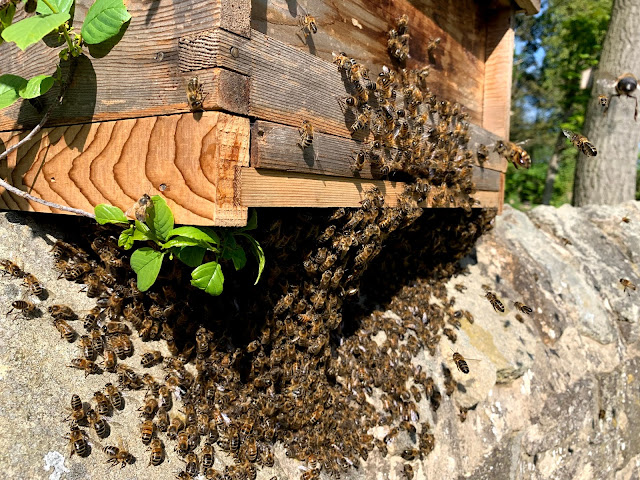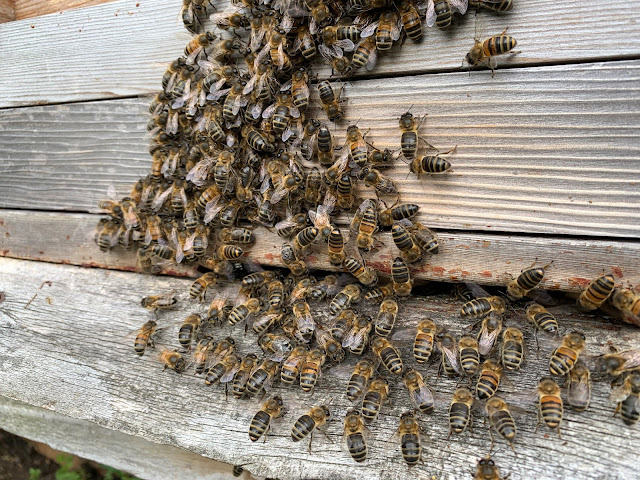Friday 23 July 2021
Front page news
Wednesday 9 June 2021
Inbound
I had been expecting a swarm because there had been lots of scout bees around my bait hive but I didn't know when it would arrive or where it was coming from. I have had a few swarms of my own after the very cold weather in most of May followed by sudden warmth at the end of the month and I suspected it would be from one of my hives. I also heard news of a swarm in a tree not far away on the other side of the golf course.
In the end the swarm's arrival was very sudden so I didn't see from which direction it came. I had walked past the bait hive a minute before with no sign of bees and when I returned there were thousands and thousands of bees in the air. Almost immediately they started filing into the box.
In retrospect the bait hive wasn't well situated as it was on top of a wall with quite an overhang. Many of the bees landed on the side of the wall and walked up towards the hive entrance.
Such was their weight as they climbed up over each other that great clumps of them broke off and fell into the grass so they had to start all over again.
It was fascinating to see how they formed chains so that the others could climb up to the entrance.
It was also interesting to see quite a few drones and some workers with pollen, all swept along in the excitement. I can tell from their colour these were not my bees and I hadn't lost a swarm that morning so I think this may have been the swarm from the golf course.
This was the scene 25 minutes after they arrived, with some still under the overhang but nearly all inside the box.
By the following morning the bees were safely installed on a friend's allotment in Jesmond. I hope they turn out to be well behaved.
Sunday 23 May 2021
A mating flight (I think)
Glancing out of the window this morning I saw a lot of bees in the air. At first I thought this was another swarm but it was coming from hive 4, which shouldn't be able to swarm as it was reduced to one sealed queen cell 10 days before. I went over to watch and there were thousands of bees in the air - and on the hive roofs and nearby raspberry canes and cane supports.
Most of the bees were just sitting around while others flew about excitedly but there was no sign of them coalescing, as in a swarm. There were a lot on the front of the hive and a clump under the landing board.
I guessed this was a mating flight but wasn't sure what stage it was at - whether this was the virgin queen leaving or returning. I watched for about an hour, hoping I might see the queen return. As I did so the fanning slowly subsided and the number of bees gradually diminished as they moved back inside.
It was cool (11℃), grey and breezy, perhaps not the best weather for a mating flight, but it has been worse recently. I read since that mating flights last for between 5 and 30 minutes so my guess is that the queen was probably already back in the hive by the time I got there. I'll wait another two or three weeks before checking that she is laying well.
Saturday 15 May 2021
Playing it safe
Tuesday 11 May 2021
In the nick of time - or was it?
Wednesday 7 April 2021
Sunday 21 February 2021
The end of lockdown
After months of cold, rain, ice and snow the bees were released from lockdown today and were out in their thousands. Although we are officially still in winter it felt like spring and there were hundreds of bees on the snowdrops. All four of my hives were very busy, suggesting they have come through the winter in good condition. It will be weeks before I can check on them but it was a delight to see bees all over the garden.
The bees get covered in pollen and spend a lot of time grooming to pack it into their pollen baskets. Here you can see the pollen brush on the inside of each basitarsus on the back legs and the partly filled corbiculae on the outside of each tibia.
The bee rubs the brushes together as part of the process of moving the pollen into the corbiculae.
All this happens while the bee is hanging from the flower by its toenails (not a technical term!).
Thursday 11 February 2021
Braving the cold
After a severe frost last night the temperature at midday today was 0℃. The weather was calm and sunny and two of my hives face south and were in full sun. I was surprised to see a few bees flying and when I went over to investigate I saw a few sunbathers. They seemed to emerge one or two at a time and stayed out for only a few minutes. Most walked around near the entrance but several took off for a fly around. They were gone for more than minute or two but I don't know how far they went or what they were up to.
Because it is warm and dark in the middle of the cluster in the hive I suppose it makes sense to send a few volunteers down each day to see what the weather is like, otherwise the bees wouldn't know. I expect on a wet and windy day they never get as far as the front door and just go back to bed. Maybe the flyers had gone to look at the snowdrops only to find they are buried in snow.
I noticed one bee with disconnected front and back wings. I assumed it had a problem but it took off without difficulty. I have heard/read that K wing deformity can be a symptom of tracheal mites or nosema but I don't know how specific a sign it is.



































